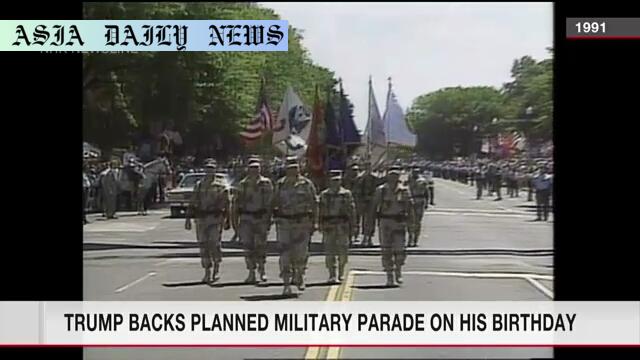Military Parade: US President Donald Trump supports plans for a large military parade on June 14 to celebrate 250 years of the US Army.
Military parade planned in Washington to mark 250 years of the US Army.
Trump supports the parade, which features vehicles, aircraft, and troops.
The last such parade occurred in 1991 after the Gulf War.
Cost of the event remains undisclosed amidst concerns over fiscal priorities.

The Context of the Military Parade
The US President Donald Trump has backed plans for a rare military parade in Washington, turning the spotlight on the US Army’s illustrious 250-year history. Scheduled to take place on June 14, the event signifies not just the birthday of the US Army, but also highlights a renewed emphasis on patriotism and national pride according to Trump’s vision. This parade will serve as an opportunity to showcase some of the most advanced military technology and capabilities, including 150 vehicles, 50 aircraft, and 6,600 troops. The President described the event as a demonstration of America’s remarkable military strength, equipped with the finest ships, tanks, and missiles.
The notion of a military parade is not without precedent. Historically, such parades have been used to bolster morale and celebrate significant milestones. The last event of this magnitude was held in 1991, commemorating the end of the Gulf War, while a proposed parade during Trump’s first term in 2018 was shelved due to concerns about operational and financial feasibility. Trump’s eagerness to proceed with this initiative underscores his commitment to honoring the armed forces while simultaneously reinforcing America’s leadership on the global stage.
Financial and Political Debate Surrounding the Parade
While the parade has received considerable attention, it has also sparked controversy regarding the costs and priorities associated with such an event. President Trump dismissed financial concerns, referring to the expense as “peanuts compared to the value of doing it.” However, critics have raised concerns over the optics of holding an extravagant celebration during a period marked by efforts to trim government expenditures and streamline operations. Political opponents and analysts fear that the substantial budget required—expected to cover the military equipment, logistical needs, and security measures—contradicts the administration’s fiscal discipline narrative.
Furthermore, the parade’s critics argue that the funds could be better allocated toward initiatives directly benefiting servicemen and women, or addressing critical sectors such as healthcare and education. These concerns resonate strongly with segments of the public, who view the fanfare as an unnecessary diversion from more pressing socio-economic issues. Nevertheless, supporters argue that the financial investment is a symbolic and necessary tribute to the sacrifices and achievements of the military over the past two and a half centuries.
The Broader Implications of Military Parades
Military parades, while celebratory in nature, also serve as showcases of national prowess and geopolitical influence. Through a deliberate exhibition of advanced weaponry and disciplined forces, nations demonstrate their readiness and resolve to both allies and adversaries. In the context of Trump’s grand vision, the June 14 parade embodies this principle, projecting a sense of American strength and unity.
On the other hand, some critics interpret such displays as a potential risk of militarizing public spaces and escalating tensions with opposing nations. In particular, the emphasis on showcasing lethal weaponry underscores concerns about nationalism and deterrence, potentially drawing criticism from peace advocacy groups. Internationally, this move may be perceived as the US reaffirming its stance as a military-superpower, which might inadvertently contribute to an arms race among competing nations.
Regardless of public opinion, this planned event is poised to be a historic moment in American history. By mixing tradition with modernity, it not only commemorates legacy but also sets the course for future advancements in defense and security. If successful, the parade could inspire similar initiatives in the years to come.
Commentary
The Symbolic Value of the Parade
It is undeniable that a military parade of this scale evokes a powerful sense of national identity and pride. As the United States celebrates the 250th anniversary of its Army, the event will likely serve as a heartfelt tribute to the country’s resilient history and its armed forces’ unwavering contributions. The grand presentation of troops and cutting-edge weaponry symbolizes America’s defense capabilities and strategic importance on the world stage.
However, amidst this celebration lies the perennial debate regarding fiscal responsibility. Critics are justified in warning against lavish spending, especially in times when critical sectors such as healthcare, education, and basic welfare demand government attention and funding. From a policy standpoint, an argument could be made for striking a delicate balance between showcasing national pride and exercising responsible governance.
The Potential Message to International Allies and Rivals
The political ramifications of hosting such an event cannot be overlooked. A large-scale military parade signals strength—a message likely not lost on America’s allies, who may feel reassured, or its adversaries, who may view it as an attempt to reaffirm dominance. These types of spectacles can, however, stir unease globally by intensifying diplomatic insecurities among nations witnessing such shows of power.
Still, when such an event is contextualized within the broader narrative of historical commemoration, it paints a more multidimensional portrait, emphasizing respect for military past and hope for a fortified future. For the administration, it likely becomes a message of unified resolve rather than sheer assertiveness.
Striking a Balanced Perspective
Ultimately, while this parade could become a source of national inspiration, the feasibility and necessity of it do warrant thorough evaluation. By addressing public concerns and ensuring transparency about its goals and costs, the administration might mitigate oppositional sentiments. At its core, the event must not only celebrate progress but also demonstrate the government’s commitment to honoring its service members responsibly while keeping citizens’ concerns at the forefront.


